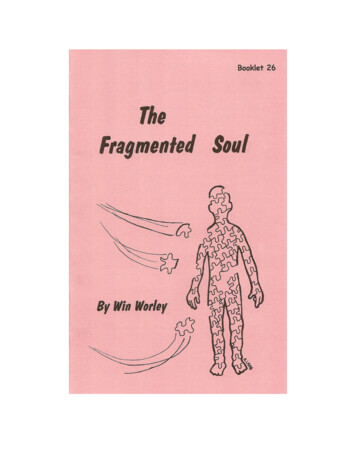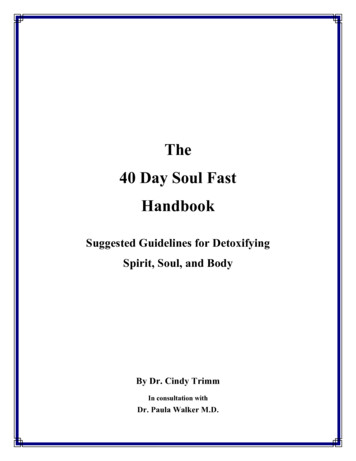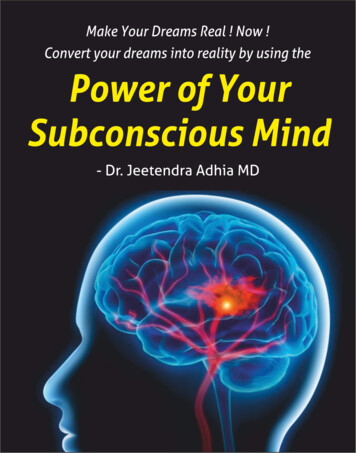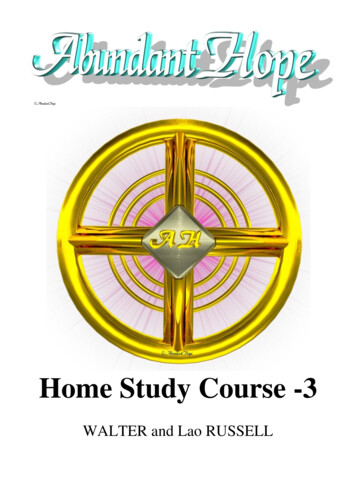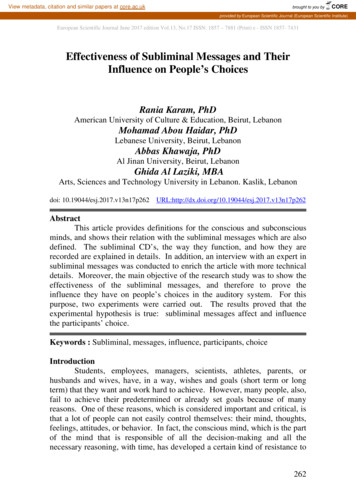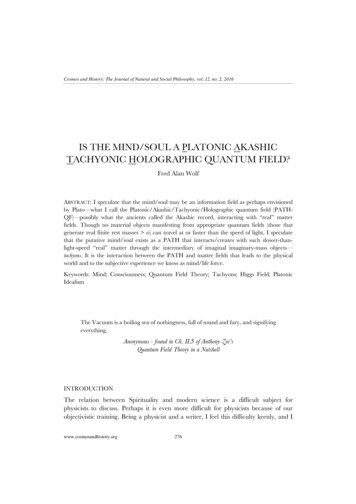
Transcription
Cosmos and History: The Journal of Natural and Social Philosophy, vol. 12, no. 2, 2016IS THE MIND/SOUL A PLATONIC AKASHICTACHYONIC HOLOGRAPHIC QUANTUM FIELD?Fred Alan WolfABSTRACT: I speculate that the mind/soul may be an information field as perhaps envisionedby Plato—what I call the Platonic/Akashic/Tachyonic/Holographic quantum field (PATHQF)—possibly what the ancients called the Akashic record, interacting with “real” matterfields. Though no material objects manifesting from appropriate quantum fields (those thatgenerate real finite rest masses 0) can travel at or faster than the speed of light, I speculatethat the putative mind/soul exists as a PATH that interacts/creates with such slower-thanlight-speed “real” matter through the intermediary of imaginal imaginary-mass objects—tachyons. It is the interaction between the PATH and matter fields that leads to the physicalworld and to the subjective experience we know as mind/life force.Keywords: Mind; Consciousness; Quantum Field Theory; Tachyons; Higgs Field; PlatonicIdealismThe Vacuum is a boiling sea of nothingness, full of sound and fury, and signifyingeverything.Anonymous - found in Ch. II.5 of Anthony Zee’sQuantum Field Theory in a NutshellINTRODUCTIONThe relation between Spirituality and modern science is a difficult subject forphysicists to discuss. Perhaps it is even more difficult for physicists because of ourobjectivistic training. Being a physicist and a writer, I feel this difficulty keenly, and Iwww.cosmosandhistory.org276
FRED ALAN WOLF277confess that at times I find some people who profess “spiritual wisdom” pretentious ifnot downright fraudulent. Nevertheless, in the following discussion I want to speculatefarther into this realm than I have done before. I believe I see how time, mind, and thespiritual nature of humankind are deeply connected, and in order to discuss thisconnection I will need to enter into the territory usually and legitimately held by theclergy and scholars of religion. I am thus treading on shaky ground for a physicist.So, let me put it as simply as I can. The key to our grasp of the true message ofspirituality is our ability to become aware of the mind—or our normal, everyday stateof subjective waking consciousness in which we think of ourselves as “I.” But what isthis “I”, really?I speculate that the mind/soul may be an information field as perhaps firstenvisioned by Plato—what I call a Platonic Akashic Tachyonic Holographic quantumfield (PATH-QF), possibly what the ancients called the Akashic record—interactingwith “real” matter fields. Though no material objects manifesting from appropriateHiggs quantum fields (those that generate real finite rest masses 0) can travel at orfaster than the speed of light, I speculate that the putative mind/soul exists as aPATH-QF—a kind of subsidiary Higgs field—that interacts with such slower-thanlight-speed “real” matter through the intermediary of imaginal imaginary-massobjects—tachyons. It is the interaction between the PATH-QF and matter fields thatleads to the physical world and the experience we know as a mind/life force. In thisspeculative work dealing with mind and quantum field theory, I subscribe to thenotion that elementary fermions (spin-½ particles) are massless fields that generateluxons (particles that travel at lightspeed and hence do not experience spacetime) untilthey interact with the Higgs field whereby through the Feynman Penrose zig-zagpicture they acquire both real and imaginary mass. In brief, I subscribe to the idea thatthe Higgs field can also act as an intermediary field carrying a mindlike qualitythrough its production of the imaginary mass (tachyonic) component when it interactswith fermion fields. My ideas are speculative at best and are still developing.HINTSThere are six speculative hints. Briefly,(1) Plato’s vision held that mathematics was the ultimate ideal, the only eternal—theessence of reality itself.(2) From Tegmark’s work (Our Mathematical Universe): We are entwined into externalreality (ER) in two distinct ways that he labels as: consensus reality (CR) and internal reality(IR).(3) From some Buddhist’s subjective and Ben Libet’s neurophysiological work, we findtime and mind don’t work in the brain and nervous system in a commonsensical way.
COSMOS AND HISTORY278We may need both findings to see that mind cannot be contained spatially in the bodyor brain or nervous system and that cause before and after effect must both temporallyarise.(4) Using the Feynman path integral (PI) approach to quantum field theory thatincludes particles emerging from the vacuum going faster-than-light, I speculate thatthere are two basic quantum fields: a real Higgs field capable of generating realpositive mass particles (fermions) and an imaginary Higgs field capable of generatingmind-like imaginary mass particles (tachyons). Such tachyons emerge in an imaginalor virtual sense.(5) Penrose’s picture of a massless spin-½ particle moving in a zig-zag fashion shows itmust move at light speed according to the Dirac equation. I label all lightspeedparticles as luxons. Since luxons suffer neither movement through space nor time(from their own point of view), I speculate that luxons appears as the progenitor ofboth space and time when subjectively experienced.(6) The latest theory uniting quantum physics and the Einstein general theory ofrelativity suggests that the entire universe can be seen as a two-dimensionalinformational structure “painted” on the cosmological horizon like a hologram. Thisholographic principle was inspired by a study of black holes; the insight was that theinformational content of all the objects which have fallen into the hole can be entirelycontained in its surface event horizon. In a larger and even more speculative sense Isee this information constituting a voxelated distribution (PATH-QF) throughoutspacetime accessible through tachyonic interaction with the matter constituting thebrain and nervous systems of sentient beings. I speculate that this PATH-QFconstitutes what ancients called the Akashic record.PLATONIC MIND/SOUL PHYSICS TODAYI am not the only physicist who sees Plato as being the forerunner of our modern viewof quantum field theory; I include Roger Penrose 1 to name one. Today in spite ofbeing immersed in the quantum age, a new understanding of how basic concepts such astime, space, and matter—the cornerstones of physics itself—really work are still amystery. What doesn’t seem to work is any purely realistic/materialistic theory.Simplistically all three concepts are products of mind.Fundamental to this mystery of why materialistic theories fail maybe the questionof the mind/soul. What, where, and when is the mind/observer? Is the world not at allas it seems to our common senses that seemingly divide spacetimematter into mindand matter moving through space and time? A movie provides an illustration of the1Penrose, Roger. Shadows of the Mind: A Search for the Missing Science of Consciousness. New York: OxfordUniversity Press, 1994.
FRED ALAN WOLF279mystery of the observer. Just as all movies do, this cinematic illusion captures us, andwe soon feel that we are no longer just an audience witnessing a screen but actualcharacters in the film. Perhaps in a similar sense as if coupled to this animated picturechimera, the “real world” inundates our senses so that we believe we live in anobjectifiable world of time and space and that anything outside of this “reality” ispurely subjective.Perhaps Plato was referring to this phenomenon in his allegory of the cave inwhich prisoners are chained so that they can only watch their shadows cast by firelightupon a wall all the while erroneously believing that they are, in fact, those images.Would we readily accept the reality behind the images if we could? It would no doubtbe quite difficult even to admit that we are “chained” by our desire to “exist” inmaterial forms. Dropping those chains without some spiritual discipline could be quitedevastating.Figure 1. Plato’s Cave.This basic dialogue between spirituality and physicality continues today althoughthe ancients might not see which side of the argument a modernist is on. Plato’s visionheld that mind/mathematics was the ultimate ideal, the only eternal thing—theessence of reality itself. If one would only take a few carefully- and perhaps spiritualitytrained glances at the physical world one would “see” what lies beyond the illusion—the basic truths of mathematical beauty. If, on the other hand, one becomes tooengrossed in the physical, one becomes chained to and polluted by it and loses sight ofthe ideal.
COSMOS AND HISTORY280PLATO’S VISION OF IDEALISM AND ANCIENT REALISM:THE FAILURE OF OUR SENSESPlato’s vision deviated from the purely rationalistic picture. The ancient Greeks,Leucippus and Democritus, pushed the idea of rationalism further than any otherphilosophers of their era and also drove our Western world onto a path that many feelwe have still to steer away from. This was the path of Rational Idealism, seeminglyseparate and distinct from pure Realism and yet encompassing it. Their idealisticconcept of reality was that real matter was made of ideally constructed atoms: simple,eternal, infinite-in-number, different in shape and size; that is, each with definiteobjective properties. These atoms existed as solid little nuts of ideal realism. But wepoor mortals could only sense these wondrous properties erroneously through ourimperfect, out-of-shape senses that always failed to see what is really out there. Thus thereal world was indeed made from ideal objects, but our senses were not capable ofperceiving them.This failure of our senses led to our mistrusting our most human abilities to discernthe world around us; a feeling that echoes in our world to this day. Truth was objectiveand out there but unfortunately hidden from our inept senses. Only through idealconceptualization was truth to be found—but not through our senses—only in ourminds. 2Hence, for ancient Greek philosophers, other than Plato, the ideal was “out there”,perceived or not, but when perceived, such perception was hopelessly distorted. Platocountered this ancient rational idealism philosophy of real non-perfect senses coupled toa real world with the notion any that any real object was an imperfect copy of its ideal.For Plato the mind took on greater significance as the only organ capable ofdetermining truth by envisioning such ideal objects. The body senses could never“see” them. The question of whether or not they were really out there became moot.The world of ideas thus emerged as God-like; the world of our senses, not to betrusted, emerged as frail error-filled human-like.Moot or not Plato’s vision of truth held that mathematics was the ultimate ideal,the only eternal—the essence of reality itself. If one would only take a few carefulglances at the physical world (just how to do this was not covered by Plato) one could“see” what lies beyond—the basic truths of mathematical beauty. If, on the otherhand, one becomes too engrossed in the physical, one becomes polluted by it and losessight of the ideal.2Similarly modern classical philosophy or realism asserts that physical objects do exist independently oftheir being perceived. However, as strange as it may appear to us, modern or perhaps post-modernidealism states physical objects may not exist at all, but instead consist of ideas, perceived or not.
FRED ALAN WOLF281TEGMARK’S MATHEMATICAL UNIVERSEPhysicist Max Tegmark in his book3 sees that: We (meaning all that is) are entwinedinto a complex and possibly multiple-universal external reality (ER) in two distinct waysthat he labels as: consensus reality (CR) and internal reality (IR). As such Tegmark believesthat the parallel universes interpretation of quantum physics is the best description ofhow ER works to answer what Douglas Adams called4 the “ultimate question of life,the universe, and everything,” namely, how CR arises from ER.Tegmark indicates this is a divisible problem; it is the job of physics to explain howCR arises from ER and the job of cognitive science to derive IR from CR.In brief he believes, as I would suspect many do, that IR implies CR which in turnimplies ER. Or in other words IR is a subset of CR which in turn is a subset of ERwhich holds them both. Thus it is entirely Venn-diagrammatically, logical that ER(blue) contains elements of reality that transcend our beliefs and observations found inCR (red) about ER and our mental representations, dreams, hopes, and thoughts, etc.found in the IR (green), of those beliefs and observations found in the CR.Figure 2. IR CR ERTegmark posits further ala Plato that the universe, the big multiversal territoryconsisting of parallel universes galore, is ER, which in turn is Mathematics (capital M)not just made describable by mathematics; but instead ER and Mathematics arecompletely equivalent, ER is Math—a kind of a possibly “madcap” Platonic universeof ideals completely expressible as mathematical concepts. In brief ER consists ofMath in some way that we mortals can only describe in a Platonic sense by themathematical tools we have come up with in our meanderings through theunknowable wilderness of the ER to make our maps, consisting of CR, which wevisualize as IR.3Tegmark. Max. Our Mathematical Universe: My Quest for the Ultimate Nature of Reality. New York: Alfred A.Knopf. 2014.4Adams, Douglas. The Restaurant at the End of the Universe. NY: Pocket Books, 1980.
COSMOS AND HISTORY282Figure 3. Math ERWell, maybe; however there is something clearly missing in all of this thatTegmark relegates to the universe of the cognitive scientists; namely consciousexperience. Not just waking conscious experience but the continual ongoing consciousexperience of life itself as certainly felt by me (even when sleeping, but not when underdeep anesthetics) and I would assume by all living animal creatures and even perhapsliving plants. And what of art and deep spiritual experience? Certainly mathematicscan be viewed as forming the skeletal structure of all art including music, sculpture,painting, poetry, and other forms of art, as our digital age and devices so aptlyindicate. However, clearly there seems to be a non-mathematical world of experiencethat is fleshed out from this skeleton to provide not only feelings of joy andappreciation, the appearance of thoughts and the sense that one has of having a mind,the cognition of our common senses, and the intuitions of the future and memories ofthe past, but also a sense of the mystery of all of that, even the mystery found in the joyof mathematical discovery.Would an overlap of the mathematics of quantum physics and the general theoryof relativity explain the mystery of such clearly conscious experiences? Decoherencetheory 5 would indicate that conscious experience plays no role in quantum physics andfrom this one would think plays no role in ER other than being a (unnecessary?) subsetof CR. Indeed it may indeed play no role in ER; if in fact there is no such thing as ERand in the Berkeleyan sense this may be true; all we have is CR implies IR.Taking the big bang into account, thus it is that mathematics is a derivation from afundamental “chaotic” Mind (with a capital M) that arose as a way of dealing with itsown chaos by attempting to place events in formal order resulting in humans thinkingabout the universe in terms of mathematics and physics in order to better survive, forexample. This chaos may itself be necessary in order that anything possibly dreamedof in IR may come to exist as CR. Thus even the thought of an abstract realm calledthe ER may be constructed as Tegmark has admirably done.In this sense, external reality implies consensus reality which in turn impliesinternal or mind reality. ER implies CR, CR implies IR, ergo ER implies IR. In the5Decoherence theory explains how super-positioned parallel universes are fuzzed out into separate realworlds.
FRED ALAN WOLF283Venn-diagrammatical logical sense IR encompasses consensus reality which in turnencompasses external reality. We are back in the cave.Figure 4. ER CR IRWHERE AND WHEN IS THE MIND?From some Buddhist spiritual thinking 6 and Ben Libet’s remarkableneurophysiological work7, we find time and mind don’t work in a commonsensicalway. We may need both approaches to see that spatially mind cannot be contained inthe body or brain or nervous system and that temporally cause before and after effectmust arise.We may allow ourselves to become a tad crazy here and forsake rationalism.BUDDHIST THINKING ALA DOUGLAS HARDINGFigure 5. What is being pointed at?6Rahula, Walpola. What the Buddha Taught. 2nd Ed. New York: Grove Press, 1974.Libet, B.: 1985, “Unconscious cerebral initiative and the role of conscious will in voluntary action”,Behavioural & Brain Sciences, 8, 529-566.Libet, B.: 2003, “Cerebral physiology of conscious experience: Experimental Studies”, in: N. Osaka (ed.),Neural Basis of Consciousness. [Advances in consciousness research series, 49] Amsterdam & New York: JohnBenjamin.Libet, B., E. W. Wright, B. Feinstein, and Dennis Pearl. “Subjective Referral of the Timing for aConscious Sensory Experience: A Functional Role for the Somatosensory Specific Projection System inMan.” Brain 102: 1 (March 1979), pp. 193–204.For my theory of Libet’s work see “The Timing of Conscious Experience: A Causality-Violating, TwoValued Transactional Interpretation of Subjective Antedating and Spatial-Temporal Projection,” Journalof Scientific Exploration, Vol. 12, No. 4. pp. 511-542. Winter, 1998.7
COSMOS AND HISTORY284We begin with the obvious—the human body. From some empirical research wehumans have found something surprising. Although there are many processes goingon in the body, none of them seem to be you! In brief, science has shown thatwhatever you are, you are not to be found in the body. So consider doing someexperiments to find out where you really are. Maybe we are looking in the wrongplace or not looking correctly.Point at an object on a wall or any other object. Notice that the object pointed toseems to be “out there,” a thing apart from you. Next, slowly rotate your finger 180degrees till you are pointing at that space from which you look out commonly referredto as your own head—that feature-less, all-encompassing space you call your head.You are pointing to “who you are at center,” as Douglas Harding would say.8 Finally,slowly rotate your finger back toward the object on the wall. Watch very carefully andtry to locate the point at which the “other thing out there” begins. Try to find thepoint at which you are no longer pointing at awareness, but are instead pointing atsomething else. Is it when you are not pointing at the “center” of your center? Is itwhen you point ten degrees off of dead center? Twenty degrees? Twenty-sevendegrees? Is there such a point where and when “the other” separates fromconsciousness or does the first-person awareness extend outward and encompass allthings? Try as you might, can you ever find where “you” ends and “other” begins?Think for a moment. Isn’t pointing outward the same experience as pointing in at anypart of your body?LIBET’S REMARKABLE FINDINGSIn a series of remarkable papers 9 probably beginning in the early 1960s, thephenomenon of “backward through time masking” was discovered. Here perceptionof a test stimulus is suppressed by a masking stimulus which is presented to the subjectsubsequently.During this time, a remarkable series of experiments probing more deeply into thisphenomenon was performed by Benjamin Libet and his coworkers at the University ofCalifornia, San Francisco Medical School. In early experiments they showed thatevents in the brain eliciting consciousness (called by Libet neuronal adequacy) ofpassive sensory “out there” events occur after the apparent awareness of these eventsand not before. In other words, conscious events and neurophysiological events arephenomenologically independent. Furthermore they may not be related in a simpletemporal cause-effect manner.89Harding, D. E. Head of Stress. London: Arkana, 1990.See end note 7.
FRED ALAN WOLF285What was the problem that Libet unearthed? In a nutshell, there appears to be aninnate fuzziness in the relationship between physical time and conscious experience.This fuzziness indicates that a precise timing of physical events marked by theapparent awareness of these events does not match a causal sequence and that at timesphysical events eliciting awareness take place after one becomes conscious of them.Ben Libet’s work has led to a good deal of controversy. What Libet and hiscoworkers discovered was then and is today quite remarkable; for Libet has given usthe first actually physical measurement of the time factor of consciousness in a humansubject. Probably most surprising, Libet has shown that in the case of a skin shock,e.g., that blocking out or “backward through time masking” can take place even if theblocking signal is delivered 300 or more msec after the applied skin shock.For various reasons, as one might rationally expect, Libet has shown thatconscious experience of external or bodily stimuli cannot occur unless the brain hastime to process data associated with them. But this leads to a temporal paradox; putbriefly, one must ask: How can a subject be aware of a sensation, that is, be consciousof it, if the subject’s brain has not registered that “awareness”?Figure 6. Libet’s findings.In the above figure 6 I have summarized Libet’s findings. In (a) we have a skinstimulus applied. The question is when is it perceived? Evidence obtained fromsubjects indicated that it was perceived nearly at the same time it was applied (perhapsas much as 50 msec later). But how can this be if the brain has not achieved neuronaladequacy?In (b) the cortical regain of the exposed brain is directly stimulated with a highfrequency (60 htz, I believe) “buzz” for approximately ¼ second. It is not perceived at
COSMOS AND HISTORY286all this supplying further evidence of Libet’s neuronal adequacy theory. The stimulatedarea of the brain is the one connected to a sensation region on the skin near theoriginal skin-stimulus site. This would indicate that the brain must be acting at a timelater than the inception of the brain signal.In (c) the brain signal is extended beyond ½ sec. After ½ second the subject indeedperceives the signal as a tingling of the skin thus seemingly showing that Libet’sneuronal adequacy model is correct. Perception requires a latency time for it to occur.In (d) a skin stimulus is applied at time 0. Later at ¼ second the brain stimulus isapplied and left on for more than ½ sec. At the ¾ second mark the brain “buzz”stimulus is perceived (tingling). Is the skin stimulus ever perceived? The answer is no—the brain stimulus seems to have interfered with its perception and the skin stimulus isnot perceived. Thus again confirming the neuronal adequacy hypothesis. This wouldindicate that the subject in (a) must be in error in believing that he perceived the skinstimulus just around the same time (50 msec later) it was applied.But in (e) a contradiction arises. The brain stimulus is applied at time 0 and left onfor more than ½ sec. Again it is perceived after ½ sec has elapsed. A skin stimulus isalso applied but now at ¼ sec. The question is: when is it perceived if at all? Based on(c) and (d) and the neuronal adequacy hypothesis, one would expect the skin stimulusto be perceived after the brain signal was experienced, perhaps as much as ½ secondafter, but no—the surprising result is that it is perceived not after the brain stimulus,but nearly ¼ second before, around the same time (within 50 msec) as it was applied tothe skin. This could indicate that the achievement of neuronal adequacy needed forthe skin stimulus to be perceived although requiring ½ second, nevertheless projectedthe sensation backwards-through-time to the time it was applied to the skin.Thus we have either a contradiction of the normal forward-through-time neuronaladequacy hypothesis or if it still holds, neuronal adequacy can project backwardsthrough-time.HIGGLEDY PIGGLEDLY HIGGSCan it be that time and causality do not play by the rules we have grown to acceptwithout question? Can what happens in the future be a cause of what happens in thepast or present? If indeed time were the same as space in that right and left wereanalogous to past and future, we would have no problem with thinking that what’s onthe left acting as a cause of what happens on the right or vice versa. To dig into this weneed to look at another hint—not only do we need to consider when and where eventsoccur, but we also need to consider what events consist of—the matter of these events,
FRED ALAN WOLF287for after all an event is something happening to something. Today this meansexamining what is called the Higgs field in quantum field theory.IN THE BEGINNING: TWO KINDS OF “LIGHT”Now when we look into quantum field theory we find that matter or energy (which isthe same thing ala Einstein’s E mc2) is made of two kinds of twisting “luxonicmatter”—a bosonic form emerging from the quantum field as photons (what wenormally call light or electromagnetic energy) and gluons (inter-nuclear energycarriers) that all have spin-1 and a fermionic form emerging as spin-½ leptons andquarks, both moving at lightspeed provided they are not interacting with this specialfield called the Higgs field. The universe of matter is then made from the interplay ofthese luxonic bosons and fermions and these in turn emerge as these two kinds ofluxonic matter: spin-1 and spin-½ luxons.LUXON ZIGZAGGING IN SPACE, DRIFTING FORWARD IN TIMEHence there would only be a universe of “light” (luxons) if someone had forgotten topush on the universal Higgs button. But it was pushed; however, the Higgs field onlyinteracts with the spin-½ luxons causing them to zigzag and change handedness 10going from right-handed as they zig and then to left-handed as they zag through space,but always moving unidirectionally forward in time as shown in Fig. 7. In this mannerthese luxons on average appear to move slower than lightspeed as tardyons and caneven appear at rest (zig-zagging back and forth at even lightspeed means you gonowhere) and thereby appearing with inertial rest masses. You can think of the Higgsfield filling the universe as if it were honey filling a jar and the luxon as if was a sporeof pollen. As the spore moves through the honey it picks up blobs of honey just as asnowball picks up snow when it rolls down a snow-covered hill, the snowball becomesmore and more inert as it gains mass.10Handedness refers to how a spin-½ particle rotates with respect the direction in which it moves. A righthanded particle always spins with its axis of spin pointing along the direction of motion while a lefthanded particle always spins with its axis pointing opposite to the direction in which it moves.
COSMOS AND HISTORY288Figure 7. Tardyon emerging from a zig-zagging forward-through-time luxon.Thus even mass has lost its massiveness. In quantum field theory the master orHiggs field, believed to fill all spacetime in a higgledy-piggledy manner, provides thenecessary matrix of interactions that bring matter into existence emerging frommassless matter (spin-½ luxons) fields.Putting Plato back into this, I view the Higgs field as also providing an alogical yetideal universal mind—a field of consciousness that permeates the higgledy-piggledyuniverse. But something else is required to complete the picture. Something that willprovide the universe a direction and order of both space and time; in other words, amind. To see how, we need to consider these luxons in a slightly different mode.LUXON ZIGZAGGING IN TIME, DRIFTING FORWARD IN SPACEIf on the other hand these massless spin-½ luxons zigzag forward and backward intime as they move unidirectionally through space, as shown in Fig. 8, they appear tomove faster than light as tachyons and thereby constitute the framework for bothannihilation and creation processes, as was so elegantly presented by RichardFeynman; it is the ability of a tachyonic or virtual process occurring between twoscattering events, say A and B, that made particles of matter going backward in timewith negative energy and faster-than-light going from A to B appear as antiparticlesgoing faster than light with positive energy and forward in time going from B to A.How a tachyon appears was dependent on the point of view of the observer of the twoevents. As Feynman put it, “one man’s virtual particle (tachyon) is another man’svirtual antiparticle (antitachyon).”
FRED ALAN WOLF289In Penrose’s thinking 11 the Higgs field interacts with luxonic electrons movingforward in time causing them to zigzag through space (go backward and forward atlightspeed) thus making them appear to move tardyonically—slower than lightspeed—and thus massively. I propose that the Higgs field also acts to zigzag luxonic electronsthrough time (go backward and forward through time at lightspeed) as well and in sodoing move tachyonically—faster than light speed. In this way we may account for thefaster-than-light “movement” corresponding to “quantum wave function collapse.”This action acts like mind. In effect memory would be contained in the Higgs field as aback reaction.Figure 8. Tachyon emerging from a zig-zagging forward-through-space luxon.DO LUXONS GENERATE SPACETIME?A key hint comes from remembering that all luxons move at lightspeed and as such donot in their own reference frames experience either space or time. For every luxononly the here and now exist. How a luxon appears, as we imagine them to travel fromone spacetime event to another, really depends on our points of view concerning thetwo spacetime separated events.Since any spatially zig-zagging luxons can be only seen on average as moving atslower than lightspeed for
envisioned by Plato—what I call a Platonic Akashic Tachyonic Holographic quantum field (PATH-QF), possibly what the ancients called the Akashic record—interacting with "real" matter fields. Though no material objects manifesting from appropriate Higgs quantum fields (those that generate real finite rest masses 0) can travel at or

